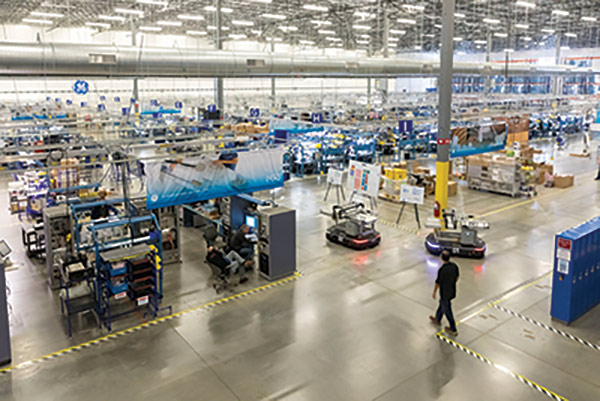GE Healthcare System Report: Lean repairs
Self-driving mobile robots improve cycle times and reduce floor space at GE Healthcare’s new repair operations center in Wisconsin.
Lean may not be the first word that comes to mind when you think of an equipment repair center. But in many respects, a repair center operates just like a manufacturing plant. Raw materials and equipment require floor space for storage, just like raw materials and work-in-process in a plant, while the work cells where equipment is disassembled, tested and repaired serve the same purpose as a production line. In that regard, it made sense for GE Healthcare to apply lean principles to its new 280,000-square-foot Repair Operations Center, or ROC, that opened in late 2015 in Oak Creek, Wisc.
Just as manufacturers need to keep the line running to meet the needs of their customers, timeliness is critical in a repair facility, especially one putting medical devices back into service. “Our customers are hospitals and healthcare facilities that need consistent, reliable and fast repairs,” says Patricio Espinosa, director of GE Healthcare’s Americas Repair Operations. “If an imaging system like an MRI is down, a hospital can miss 10 or 20 life-saving diagnostics in a day. They need it back up right away.”
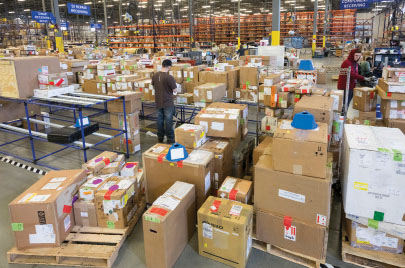
Minimizing the footprint of repair cells, optimizing the space allocated to storage, and optimizing the flow of materials through the facility were among the goals that guided the design of the ROC, according to Espinosa. The Wisconsin facility, which repairs some 2,000 medical devices each week, consolidated multiple sites located throughout the United States into one center of excellence located near GE Healthcare’s design and manufacturing centers near Milwaukee.
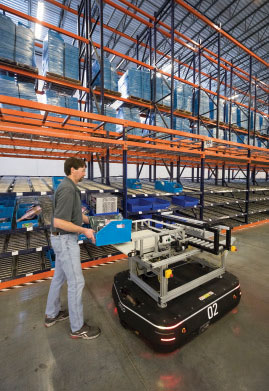 The facility is an early adopter of self-driving mobile robots (OTTO Motors), which are used to manage the flow of work through the facility. On the front end of the process, the vehicles deliver bins of raw materials and parts to be repaired to work cells; on the back end of the process, they are used to deliver completed parts to a conveyor that services the packing and shipping areas. One key feature of the mobile robots is their ability to self-navigate and automatically re-plan a new route if the original route to a destination is blocked or unavailable.
The facility is an early adopter of self-driving mobile robots (OTTO Motors), which are used to manage the flow of work through the facility. On the front end of the process, the vehicles deliver bins of raw materials and parts to be repaired to work cells; on the back end of the process, they are used to deliver completed parts to a conveyor that services the packing and shipping areas. One key feature of the mobile robots is their ability to self-navigate and automatically re-plan a new route if the original route to a destination is blocked or unavailable.
The new facility has achieved a 60% better utilization of space through better design—40% to 45% of which can be attributed to the self-driving vehicles, says Espinosa. And, after just one year of operation, GE Healthcare has realized 80% of the ROI it originally targeted for the vehicles. “We plan on adding a second shift, which will allow us to further leverage the capabilities of the vehicles,” Espinosa adds. “When we do that, we expect to meet or exceed our original ROI target.”
The software system that collects data about the operation of the mobile robots is allowing Espinosa to reach another goal: the digitization of the business. It’s an example of GE’s Brilliant Factory, an initiative that GE says is “ushering in a new era in manufacturing by merging hardware and software and reimagining how products are designed, made and serviced.” The idea is to combine “lean manufacturing, advanced and additive manufacturing with advanced software analytics to enhance productivity.” Self-driving vehicles are certainly part of that equation.
Healthcare equipment
With more than $18 billion in 2016 revenue, GE Healthcare is a leading producer of medical technologies and services, including medical imaging and information technologies, medical diagnostics equipment, and patient monitoring systems, to name a few. Headquartered in Chicago, the GE Healthcare unit operates in more than 100 countries.
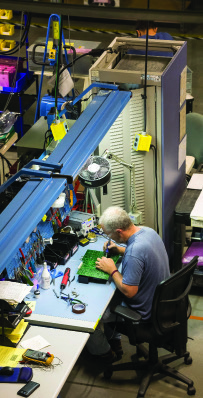 The new Wisconsin facility is part of the aftermarket services unit, which oversees warranty management and repairs of GE Healthcare equipment. “When a product needs warranty servicing or a repair that is not completed in house by the hospital or facility, we have engineers who go into the field to take care of those issues,” says Espinosa. “If a repair can’t be made in the field for some reason, the equipment is sent to us.”
The new Wisconsin facility is part of the aftermarket services unit, which oversees warranty management and repairs of GE Healthcare equipment. “When a product needs warranty servicing or a repair that is not completed in house by the hospital or facility, we have engineers who go into the field to take care of those issues,” says Espinosa. “If a repair can’t be made in the field for some reason, the equipment is sent to us.”
While it is not unusual for a hospital to have backup equipment for imaging and life support machines, it’s still essential that the units are repaired and put back into service as quickly as possible, especially in facilities with large patient loads.
Prior to opening the ROC in late 2015, repairs were done at multiple smaller facilities located around the country. “The idea behind a center of excellence was to leverage all that we do in GE Healthcare,” Espinosa says. The new location, for instance, provides the services division with ready access to the engineers who design the machines, leading to more reliable and higher quality repairs.
Consolidating repairs into one location also created an opportunity for leaner and more efficient operations. “A lot of what we did in the old facilities was redundant and non-value add,” Espinosa explains. For instance, in the old facilities, parts and machines moved through the plants on a milk route. Once an hour, someone would pick up repaired equipment at the work cells and deliver it to shipping. At least, that’s the way it was supposed to happen. In reality, some technicians were responsible for getting their repairs to shipping and would wait until the end of a shift to make their deliveries, inundating shipping at the end of the day.
The old facilities were also laid out inefficiently. Incoming equipment was sent directly from receiving to a repair cell, which required a system of space-consuming storage racks at the workstations. Technicians also spent part of their shift walking back and forth to parts and raw materials storage areas to grab the items they needed to complete a repair.
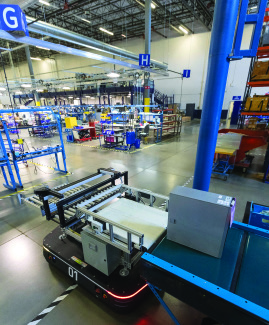 The new facility was designed to eliminate those issues. A flow rack storage area was installed near receiving to hold incoming equipment until a technician at one of the 250 repair cells is ready for work. Instead of holding a large inventory of raw materials and components near the work cells, the new facility uses a Kanban system similar to an automotive plant: No more than two bins of a SKU are stored in flow racks at a work cell. When a bin is empty, it is sent to a materials area to be refilled while the technician begins to draw from the second bin.
The new facility was designed to eliminate those issues. A flow rack storage area was installed near receiving to hold incoming equipment until a technician at one of the 250 repair cells is ready for work. Instead of holding a large inventory of raw materials and components near the work cells, the new facility uses a Kanban system similar to an automotive plant: No more than two bins of a SKU are stored in flow racks at a work cell. When a bin is empty, it is sent to a materials area to be refilled while the technician begins to draw from the second bin.
Likewise, repaired equipment is delivered to packing as soon as possible after a repair is finished; that creates a level workload in packing to ensure shipments go out in a timely fashion. Lean principles are also at work in packing, where GE Healthcare uses equipment to generate shipping boxes on demand and at the right size for that shipment. The system eliminates wasted corrugate.
Automated Kanban
Rethinking receiving, storage and packing processes was an important step. The next challenge for Espinosa and his team was to automate the physical movement of goods through the facility, essentially creating an automated Kanban. The facility deals with a high mix of products that are serviced in a relatively low-volume environment. Each of the cells has from one to six technicians, depending on the type of equipment serviced, and they have different start times and cycle times.
To maintain a steady flow of work and materials, Espinosa wanted to eliminate the milk run. In its place, he was looking for “something like an Uber that is on demand for when a technician calls for a piece of equipment to be repaired or when something is ready for shipping.”
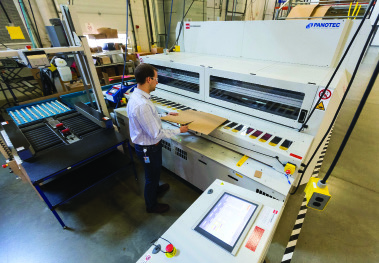 One team member was tasked with reviewing the options available, including automatic guided vehicles (AGVs) and the new generation of mobile robots. Conducted over a four-month period, the team reviewed seven different companies and put five different solutions through their paces in the facility.
One team member was tasked with reviewing the options available, including automatic guided vehicles (AGVs) and the new generation of mobile robots. Conducted over a four-month period, the team reviewed seven different companies and put five different solutions through their paces in the facility.
“One of the things we wanted to see was whether a supplier could get their solution up and running right away in our facility,” Espinosa says. Many solutions available in the market follow magnetic tape; some can be programmed to follow specific routes; some pull the equipment on carts behind a tugger; and some carry the equipment on top of the vehicle.
The determining factor in the selection of the self-driving vehicles was their ability to re-route on the fly. “From what we observed, many solutions available today are designed to go from Point A to Point B, like on a one-way street,” Espinosa says. “For example, if an aisle is blocked, we would have to move things around before the vehicle could continue. With conventional AGVs, we would have to move the tape if we changed our design.”
Self-driving vehicles, on the other hand, have on-board intelligence that allows them to calculate an alternative route if they can’t follow a prescribed route. “We do a daily lean meeting in one of the aisles,” Espinosa says. “If we’re standing there, the vehicle will wait 30 seconds and if we don’t move, it will automatically find another route. That flexibility was one of the great efficiencies we saw in these vehicles.”
A second requirement was that the software was simple to use. Technicians only have to choose between three options: Are they ready for the next part to be repaired; do they want to send a repaired part to shipping; or do they need to replenish a bin of raw materials? “Every technician has a computer in their cell and they can access the software through a Web page,” Espinosa says. “When they call for a vehicle, the software knows where they are located and where the vehicle needs to go next.”
Finally, the vehicles can automatically integrate with the conveyor system that services the packing and shipping areas.
Leap into automation
For a division that previously relied on conventional, manual materials handling processes, the transition to mobile robots represented a leap into automation, according to Espinosa. There was a learning curve. “When you’re consolidating multiple sites and introducing robotics and conveyors, there’s a lot of change,” says Espinosa.
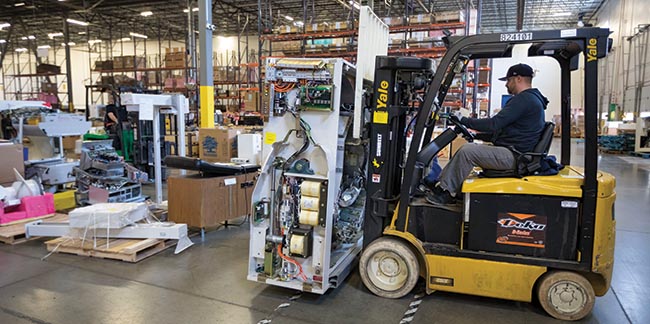
On the one hand, technicians quickly warmed to the technology. Training consisted of a session on how to safely interact with the vehicles, which is now required of every new employee, and how to access the software Web page and choose a task. “Since they only have to click one of three buttons, it was very simple,” Espinosa says. “From a cultural standpoint, it was one of the easiest implementations I’ve ever done.”
Another task was the design of the appliances that hold the repair parts in place during travel and transfer them onto the conveyor in the packing area. Those were designed in-house by GE engineers.
Although the system is not presently integrated with a warehouse management system (WMS)—a master scheduler currently decides which products have the highest priority and need to be repaired first rather than a computerized system—the biggest challenge was the integration of the vehicle and conveyor software systems with the GE network. “We’re a very large company, and when you’re working with a large company, there is not an easy path to getting connected to the network,” Espinosa says. “The vehicle solution provider and the conveyor integrator worked very closely with GE.”
There was also a learning curve in adapting the vehicles to a manufacturing environment, which was a first. “We learned a lot, and, if GE implements this solution in another facility, the solutions are now in place to make this go much faster,” Espinosa says. Indeed, he has plans to add a second shift that will allow him to leverage the current investment made in the present system and more vehicles in the future.
“If we go to a second or third shift, or add more vehicles, all of the assets are already in place and it can be easily done,” he says. Finally, there have been improvements to the software since the initial implementation that have optimized how the vehicles complete a task and move to the next operation. Those, he says, have significantly reduced travel and cycle times.
After nearly a year of operation with the self-driving vehicles, Espinosa has identified three key benefits of the new facility and automation. For one, technicians better use their time on value-added activities, instead of retrieving raw materials and taking product to shipping. For another, it has brought a new dimension of flexibility to processes; if something changes in the layout of the facility, the mobile robots can easily adapt. Finally, the vehicle software is allowing GE Healthcare to digitize the physical flow of materials through the facility, aligning with GE’s Brilliant Factory strategy.
Espinosa notes that he is presently only using the vehicles in about a third of the building. “What we’re doing today are the core activities we identified when we purchased the vehicles,” he says. “But I really believe we’re just scratching the surface of the operations we can enable in the future.”


